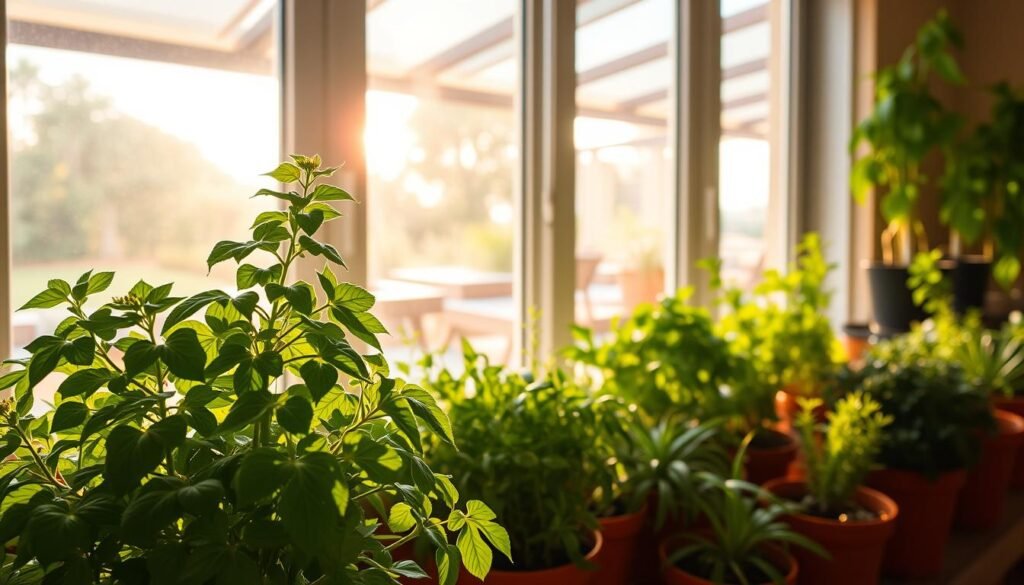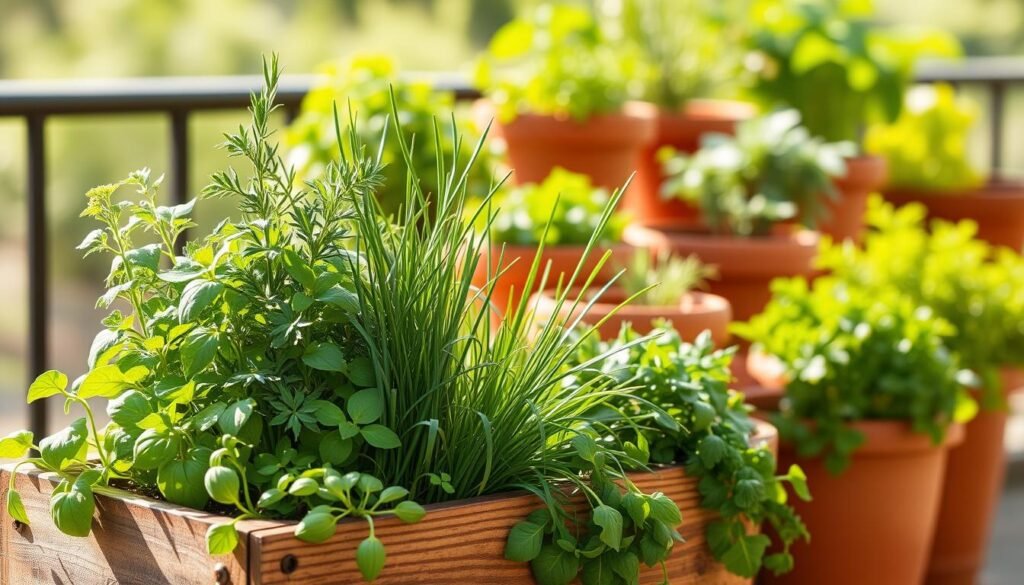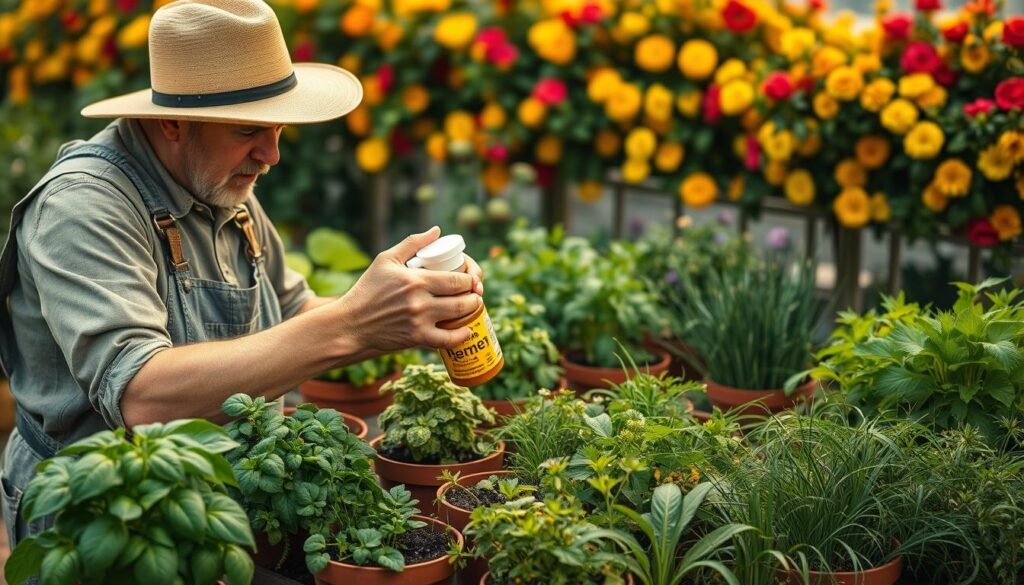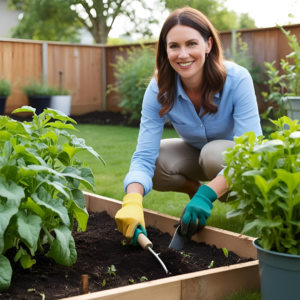Did you know that over 30% of American households grow some form of plants at home? Whether you have a sprawling backyard or just a small balcony, you can enjoy the benefits of fresh herb container gardening.
Growing your own plants is easier than you might think. With the right care, you can have a steady supply of fresh ingredients right at your fingertips. Imagine plucking basil for your pasta or mint for your tea—straight from your own mini garden.
This method is perfect for small spaces. You don’t need a lot of room to start. A simple pot with good drainage and quality soil is all you need to get going. Plus, it’s a rewarding way to add a touch of green to your home.
Key Takeaways
- Start with a small pot and basic plants like basil or mint.
- Choose a sunny spot for optimal growth.
- Use well-draining soil to keep roots healthy.
- Water regularly but avoid overwatering.
- Enjoy fresh flavors straight from your home garden.
Getting Started with Herb Container Gardening
Transforming a small corner of my home into a green oasis was easier than I expected. I’ve always loved the idea of having fresh ingredients at my fingertips, but I didn’t think it was possible in my apartment. That changed when I discovered the simplicity of growing in pots. I also wanted to start gardening to burn extra calories.
My First Steps and Inspiration
My journey began with a few basic plants like basil and chives. These are forgiving and perfect for beginners. I started with a small pot, some quality soil, and a sunny spot by the window. Within weeks, I was snipping fresh leaves for my meals.
I was inspired by the idea of having a mini garden that didn’t take up much space. It’s amazing how a few pots can bring so much life to a small area. Plus, the process is incredibly rewarding.
Benefits for Small Spaces
If you’re short on space, this method is ideal. A balcony, patio, or even a windowsill can become a thriving garden. I grouped compatible plants together to maximize the use of my limited area. For example, basil and parsley grow well in the same pot.
Maintenance is simple. Regular watering and a bit of sunlight are all it takes. Harvesting is even easier—just snip a few leaves, and the plant keeps growing. It’s a sustainable way to enjoy fresh flavors year-round.
| Plant | Sunlight Needs | Watering Tips |
|---|---|---|
| Basil | 6+ hours daily | Keep soil moist |
| Chives | Partial sun | Water when dry |
| Parsley | Partial sun | Keep barely moist |
Starting small gave me the confidence to expand my garden. If I can do it, so can you. Next, let’s talk about choosing the right pot and soil mix to set your garden up for success.
Selecting the Ideal Containers and Potting Mix
The success of your mini garden starts with the right tools. Choosing the proper pot and soil mix is essential for healthy growth. Let’s break down what you need to know to set your plants up for success.
Choosing Containers with Drainage Holes
Drainage is critical for any plant. Without it, water can pool at the bottom, leading to root rot. Always pick pots with holes at the base to let excess water escape. This keeps the soil balanced and your plants thriving.
When selecting a pot, consider the size of your plant’s root system. Basil, for example, needs extra space to grow. Smaller plants like thyme or oregano can do well in compact pots. Match the container to your plant’s needs for the best results. You can learn more about the process in my bucket gardening tutorial.

Finding the Perfect Soil
High-quality soil is the backbone of a healthy garden. Look for a mix that retains moisture but still drains well. This ensures your plants get the water they need without drowning their roots.
A good potting mix also provides essential nutrients. This reduces the need for frequent fertilization. For herbs like rosemary or parsley, a nutrient-rich soil can make all the difference in flavor and growth.
Don’t forget to repurpose old containers or upcycle household items. It’s a creative way to save money and reduce waste. Just make sure they have proper drainage and are the right size for your plants.
Understanding Sunlight, Water, and Soil Requirements
Every plant has unique requirements for sunlight, water, and soil. Meeting these needs is the foundation of a healthy garden. Whether you’re growing basil or rosemary, understanding their preferences ensures they thrive.
Matching Plants to Their Environmental Needs
Different plants have different preferences. Basil loves heat and full sun, while parsley thrives in steady moisture. Matching your plants to their ideal conditions is crucial for success.
Most plants need at least six hours of sunlight daily. Full sun plants like rosemary require eight hours or more. Partial sun plants, such as thyme, do well with four to six hours.

Effective Watering Techniques
Watering is a balancing act. Too much water can drown roots, while too little can cause drooping. A deep soak followed by a drying period works best for most unique garden plants.
Check the soil moisture regularly. Stick your finger an inch into the soil—if it feels dry, it’s time to water. Morning is the ideal time to water, as it prevents evaporation and gives plants time to absorb moisture.
| Plant | Sunlight Needs | Watering Tips |
|---|---|---|
| Basil | 6+ hours daily | Keep soil moist |
| Thyme | 4-6 hours daily | Water when dry |
| Oregano | 6+ hours daily | Let soil dry slightly |
| Parsley | Partial sun | Keep soil consistently moist |
Well-draining soil is essential. It prevents waterlogging and ensures roots get the oxygen they need. A nutrient-rich mix also supports healthy growth and enhances flavor.
By understanding these needs, you can create the perfect environment for your plants. This not only boosts their growth but also improves the taste of your harvest.
Planting Your Favorite Herbs in Containers
Planting your favorite herbs in pots can be both fun and rewarding. Whether you’re a beginner or a seasoned gardener, grouping compatible plants together ensures they thrive. By understanding their needs, you can create a lush, flavorful mini garden.
Grouping Compatible Herbs Together
When planning your pot, consider herbs with similar water, sun, and soil needs. For example, basil and oregano both love full sun and well-draining soil. Pairing them in one pot allows them to grow harmoniously.
Here are some tips for grouping herbs:
- Water Requirements: Pair herbs like thyme and rosemary, which prefer drier soil, together. Avoid mixing them with moisture-loving plants like parsley.
- Sun Preferences: Group herbs that need six or more hours of sunlight daily, such as basil and sage, in the same pot.
- Mature Size: Ensure each plant has enough space to grow. Overcrowding can stunt growth and reduce flavor.
I’ve found that thoughtful grouping simplifies maintenance. For instance, I paired basil and oregano in one pot, and they flourished without competing for resources. This approach also creates an aesthetically pleasing arrangement.
By matching herbs with similar needs, you’ll save time and effort. Plus, your plants will reward you with vibrant growth and fresh flavors. Start small, experiment, and enjoy the process of creating your own herb haven.
Caring for Your Herb Garden Throughout the Season
Keeping your plants healthy and thriving requires consistent care throughout the year. From pruning to harvesting, each step ensures your garden remains lush and productive. With a little attention, you can enjoy fresh flavors all season long.

Pruning and Harvesting Tips
Regular pruning is key to encouraging fuller growth. I always clip my plants early in the day when their essential oils are strongest. This preserves their flavor and aroma. For herbs like basil and mint, I use the “snip and pinch” method to prevent flowering too early.
Harvesting frequently actually stimulates growth. When I trim leaves, I make sure to leave enough for the plant to recover. This ensures a steady supply of fresh ingredients for my kitchen.
Seasonal Adjustments
As the seasons change, so do the needs of your garden. During hotter months, I increase watering to keep the soil moist. In cooler weather, I reduce it to prevent overwatering. This balance keeps roots healthy and plants thriving.
I also rearrange or transplant plants that become overcrowded. This gives them more space to grow and prevents competition for nutrients. It’s a simple way to maintain a healthy garden year-round.
Balancing Fertilization
Fertilizing is important, but overfeeding can harm your plants. I use a light, organic fertilizer every few weeks to provide essential nutrients. This supports growth without overwhelming the roots.
By paying attention to these details, I’ve seen my garden flourish. It’s a rewarding process that brings fresh flavors to my meals and joy to my home.
Dealing with Common Container Gardening Challenges
Every gardener faces challenges, but with the right approach, you can overcome them. Whether it’s pests, overcrowding, or maintenance issues, proactive care ensures your plants thrive. Let’s explore practical solutions to keep your garden healthy and vibrant.
Pest Control and Maintenance Tips
Pests like aphids, spider mites, and whiteflies can harm your plants. I’ve found that organic remedies work best. Neem oil is my go-to solution—it disrupts pests’ life cycles without harming beneficial insects. Another effective option is insecticidal soap, which targets soft-bodied pests like aphids.
Regular maintenance is equally important. Clean your pots and tools to prevent mold or disease. A simple bleach solution (one part bleach to nine parts water) works wonders for sterilization. Routine inspections help catch issues early, saving you time and effort in the long run.
“Prevention is better than cure. A little care today can save your garden tomorrow.”

Managing Overcrowding in Your Pots
Overcrowding is a common issue in small spaces. When plants compete for resources, their growth and flavor suffer. I always check for signs like stunted growth or yellowing leaves. Transplanting or thinning out plants ensures each one has enough space to thrive.
Here’s a quick guide to spacing popular plants:
| Plant | Spacing |
|---|---|
| Basil | 6-8 inches |
| Thyme | 4-6 inches |
| Parsley | 8-10 inches |
By addressing these challenges, you’ll create a healthier, more productive garden. Remember, every problem has a solution—stay observant and proactive!
Creative Container Ideas for a Beautiful Herb Display
Adding a personal touch to your garden can make it truly unique. Upcycling household items not only saves money but also adds character to your space. With a little creativity, you can turn everyday objects into charming homes for your favorite plants.

Upcycling Household Items as Unique Containers
I’ve experimented with repurposing old mugs, jars, and even vintage tins. Each item brings its own story and style to my garden. The key is to ensure they have proper drainage. Without it, water can pool and harm the roots.
Here are some tips for transforming household items into functional pots:
- Drainage Holes: Drill small holes at the bottom to let excess water escape. This keeps the soil healthy and prevents root rot.
- Size Matters: Choose items that match the plant’s root system. Basil, for example, needs more space than thyme.
- Decorate: Paint or decorate the containers to reflect your style. It’s a fun way to personalize your garden.
I’ve used old teacups for smaller plants like parsley and mint. Larger items, like vintage tins, work well for rosemary or sage. The possibilities are endless, and the results are always unique.
Creativity doesn’t stop at functionality. Stylish containers can complement your outdoor décor and add personality to your space. Whether it’s a colorful jar or a rustic tin, each piece tells a story and enhances the beauty of your garden.
By upcycling, you’re not just creating a beautiful display—you’re also reducing waste. It’s a win-win for both your garden and the environment. So, grab those old items and let your imagination run wild!
Enhancing Flavor and Growth with the Right Fertilizers
Balancing nutrients in your garden can make all the difference in flavor and growth. Too much fertilizer can overwhelm your plants, while too little leaves them undernourished. Finding the right balance ensures your plants thrive and taste their best.
Why Over-Fertilizing Harms Flavor
Overfeeding your plants can actually reduce their natural flavors. Excess nutrients lead to rapid growth, which dilutes the essential oils that give herbs like basil and rosemary their distinct taste. A balanced approach keeps flavors rich and vibrant.
I’ve found that applying a light, organic fertilizer every month during the growing season works best. This provides steady nutrients without overwhelming the roots. It’s a simple routine that keeps my plants healthy and flavorful.
Choosing the Right Fertilizer
Not all fertilizers are created equal. For container-grown plants, I recommend organic options. They support long-term soil health and enhance flavor. Granular fertilizers are great, but avoid applying them to dry soil to prevent root damage.
Here’s a quick comparison of fertilizer types:
- Organic: Slow-release, improves soil health, enhances flavor.
- Granular: Easy to apply, but requires moist soil.
- Liquid: Quick absorption, ideal for fast-growing plants.
Techniques for Even Application
Applying fertilizer evenly ensures all parts of the plant receive nutrients. I use a watering can for liquid fertilizers and sprinkle granular options lightly around the base. Always water after applying to help nutrients reach the roots.
Periodic checks are essential. I monitor my plants for signs of stress, like yellowing leaves or stunted growth. Adjusting the fertilizer dosage keeps them healthy and thriving.
By balancing nutrients carefully, you’ll enjoy stronger growth and richer flavors. It’s a small effort that makes a big difference in your garden.
Grow Your Herb Container Today
Starting a small garden has been one of the most rewarding experiences in my life. From selecting the right pot to finding the perfect spot for sunlight, every step has taught me something new. Watching my plants grow and thrive has brought so much joy and a sense of accomplishment.
If you’re just beginning, don’t be afraid to experiment. Start with a few easy-to-grow varieties and see what works best for your space. Remember, even a small garden can make a big difference in your home and lifestyle.
Thank you for joining me on this journey. I’d love to hear about your experiences and see how you’ve made your space greener. Together, we can create a world where every small effort contributes to a healthier, more vibrant environment.
FAQ
What’s the best way to start growing herbs in pots?
I began by choosing a sunny spot and picking pots with drainage holes. Then, I filled them with well-draining soil and planted my favorite varieties like basil and thyme.
How much sunlight do herbs need each day?
Most herbs thrive with at least 6 hours of direct sun daily. I make sure my pots are placed where they can soak up plenty of light for healthy growth.
Can I grow different herbs together in one pot?
Yes, but I group herbs with similar needs. For example, rosemary and sage work well together because they both prefer drier soil and lots of sun.
How often should I water my potted herbs?
I check the soil daily and water when the top inch feels dry. Overwatering can harm the roots, so I always ensure proper drainage.
What’s the best soil for growing herbs in containers?
I use a high-quality potting mix that drains well. Adding a bit of compost can boost nutrients and help my plants thrive.
How do I prevent pests in my herb garden?
I inspect my plants regularly and use natural remedies like neem oil or insecticidal soap to keep pests at bay without harsh chemicals.
Can I use household items as containers for herbs?
Absolutely! I’ve repurposed old mugs, tin cans, and even wooden crates. Just make sure to add drainage holes to avoid waterlogging.
How do I keep my herbs growing strong all season?
I prune regularly to encourage bushier growth and harvest often. A balanced fertilizer every few weeks also helps maintain their health.
What herbs are easiest to grow in pots?
I’ve had great success with basil, mint, and parsley. They’re low-maintenance and adapt well to container life.
How do I know if my herbs are getting too crowded?
If the leaves start yellowing or growth slows, it’s time to thin them out. I gently separate the plants and repot them for better airflow and space.

